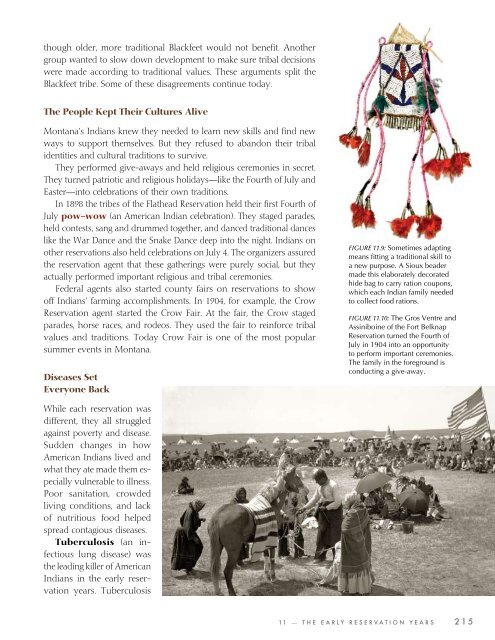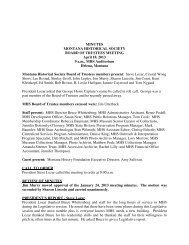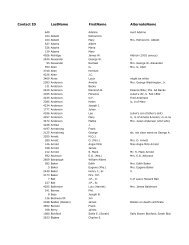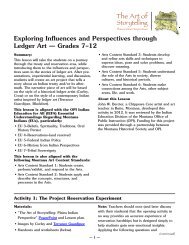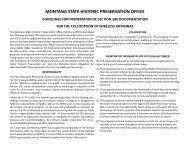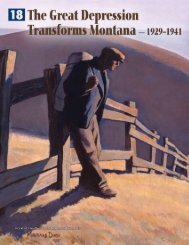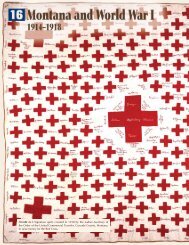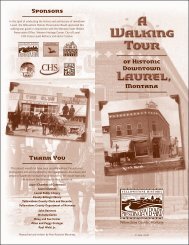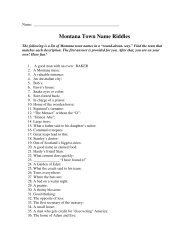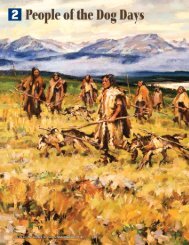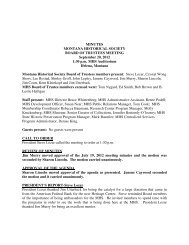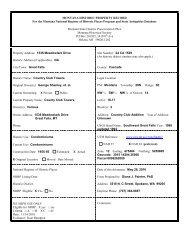Chapter 11 - Montana Historical Society
Chapter 11 - Montana Historical Society
Chapter 11 - Montana Historical Society
Create successful ePaper yourself
Turn your PDF publications into a flip-book with our unique Google optimized e-Paper software.
though older, more traditional Blackfeet would not benefi t. Another<br />
group wanted to slow down development to make sure tribal decisions<br />
were made according to traditional values. These arguments split the<br />
Blackfeet tribe. Some of these disagreements continue today.<br />
The People Kept Their Cultures Alive<br />
<strong>Montana</strong>’s Indians knew they needed to learn new skills and fi nd new<br />
ways to support themselves. But they refused to abandon their tribal<br />
identities and cultural traditions to survive.<br />
They performed give-aways and held religious ceremonies in secret.<br />
They turned patriotic and religious holidays—like the Fourth of July and<br />
Easter—into celebrations of their own traditions.<br />
In 1898 the tribes of the Flathead Reservation held their fi rst Fourth of<br />
July pow-wow (an American Indian celebration). They staged parades,<br />
held contests, sang and drummed together, and danced traditional dances<br />
like the War Dance and the Snake Dance deep into the night. Indians on<br />
other reservations also held celebrations on July 4. The organizers assured<br />
the reservation agent that these gatherings were purely social, but they<br />
actually performed important religious and tribal ceremonies.<br />
Federal agents also started county fairs on reservations to show<br />
off Indians’ farming accomplishments. In 1904, for example, the Crow<br />
Reservation agent started the Crow Fair. At the fair, the Crow staged<br />
parades, horse races, and rodeos. They used the fair to reinforce tribal<br />
values and traditions. Today Crow Fair is one of the most popular<br />
summer events in <strong>Montana</strong>.<br />
Diseases Set<br />
Everyone Back<br />
While each reservation was<br />
different, they all struggled<br />
against poverty and disease.<br />
Sudden changes in how<br />
American Indians lived and<br />
what they ate made them especially<br />
vulnerable to illness.<br />
Poor sanitation, crowded<br />
living conditions, and lack<br />
of nutritious food helped<br />
spread contagious diseases.<br />
Tuberculosis (an infectious<br />
lung disease) was<br />
the leading killer of American<br />
Indians in the early reservation<br />
years. Tuberculosis<br />
FIGURE <strong>11</strong>.9: Sometimes adapting<br />
means fi tting a traditional skill to<br />
a new purpose. A Sioux beader<br />
made this elaborately decorated<br />
hide bag to carry ration coupons,<br />
which each Indian family needed<br />
to collect food rations.<br />
FIGURE <strong>11</strong>.10: The Gros Ventre and<br />
Assiniboine of the Fort Belknap<br />
Reservation turned the Fourth of<br />
July in 1904 into an opportunity<br />
to perform important ceremonies.<br />
The family in the foreground is<br />
conducting a give-away.<br />
1 1 — T H E E A R L Y R E S E R V A T I O N Y E A R S 2 1 5


